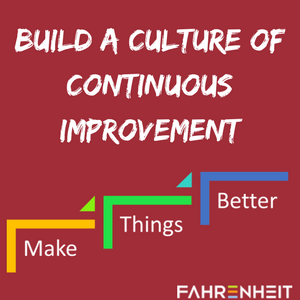How to Build and Maintain a Culture of Continuous Improvement

Have you ever worked for an organization where change was not embraced and the status quo was expected? How did you feel about that experience? I have, and personally I found it to be disengaging to the point that I sought to leave that organization quickly. Employees want to be engaged and valued; they want to learn and grow and help make a difference — at least the ones worth retaining do. A culture of continuous improvement provides such an environment, and the benefits include helping an organization grow, meeting marketing demands/changes, and helping it to stand out from the competition. Ultimately, this can bring in increasing profits.
So, how do you implement this as part of your culture? Below are some important steps to consider in that process; however, keep in mind that what works for one company may not work for another (i.e. it may depend on size of the organization or a business unit within an organization, or the specific item being addressed). Also, remember that maintaining this culture is just as important as building it. Last, but not least, remember that any meaningful change takes time and work.
HOW TO BUILD A CULTURE OF CONTINUOUS IMPROVEMENT
STEP 1. Top Down Approach – You Must Believe
First, it must start at the top. It is a leadership approach to encourage your employees to engage in innovation that involves open communication, questioning, learning, and even taking the opportunity to potentially fail. If leaders do not buy in, employees will not either.
STEP 2. Research Best Practices – Get Help
Seek out other organizations who have a successful continuous improvement culture to learn what works and what doesn’t. Don’t just focus on the largest and best, as what works for one may not work for another. For instance, what may work for a large organization may not translate well to a smaller one. Find the best fit for your organization based on size, industry, and other relevant factors. Also, remember that at times innovation and creativity do not fit into some data driven models and allow for this.
STEP 3. Be Prepared to Answer “Why”
This is necessary to alleviate confusion. If folks do not understand the “why” behind something, then the value provided will most likely be minimal. This is true for most situations. Once the “why” is understood, value can increase exponentially. Speak as to why the culture and method chosen are important. If you don’t, you will most likely lose the interest of your employees and acceptance of the change will be difficult, if not impossible.
STEP 4. Provide Vision
You may hear, “I don’t know what to improve” or “It can’t be done any better.” Be prepared for this, especially in the early stages when it is essential to provide guidance on what the change means and what expectations are. Training and coaching will help familarize your workforce with the culture change. Provide clear-cut, simple examples that relate to all when rolling it out.
STEP 5. Be Open – Trust is Key
Your employees have to trust you. You have to be open to criticism and feedback without becoming defensive. If you want your employees to accept this new culture and question the status quo to bring about positive change, you have to be a leader/role model that supports the culture change. Also, encourage creativity and be open to all ideas. Even if one does not work, help the employee understand why it doesn’t work, while at the same time showing appreciation for the effort.
STEP 6. Recognize Employee Efforts
Recognizing employee efforts and achievements is crucial. It shows that you value what they have done, even if it failed or did not result in any benefit. You want to reward those efforts, along with the achievements, to ensure the culture is encouraged and supported no matter the outcome. Absent any recognition, employees will disengage from the culture you are trying to achieve.
Ann Wilson is a Senior Consultant at The Fahrenheit Group. She has more than 20 years experience in accounting/audit, project, and change management in a variety of industries. Ann particularly enjoys process/continuous improvement and helping our clients create efficiencies, reduce costs, and achieve desired results. If you would like to learn more about continuous improvement and how it can benefit your company, we can help! Just reach out to Ann or one of our other knowledgeable consultants to learn more.